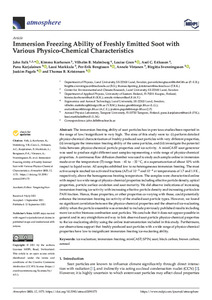Immersion freezing ability of freshly emitted soot with various physico-chemical characteristics
Falk, John; Korhonen, Kimmo; Malmborg, Vilhelm B.; Gren, Louise; Eriksson, Axel C.; Karjalainen, Panu; Markkula, Lassi; Bengtsson, Per Erik; Virtanen, Annele; Svenningsson, Birgitta; Pagels, Joakim; Kristensen, Thomas B. (2021-09)
Falk, John
Korhonen, Kimmo
Malmborg, Vilhelm B.
Gren, Louise
Eriksson, Axel C.
Karjalainen, Panu
Markkula, Lassi
Bengtsson, Per Erik
Virtanen, Annele
Svenningsson, Birgitta
Pagels, Joakim
Kristensen, Thomas B.
09 / 2021
1173
Julkaisun pysyvä osoite on
https://urn.fi/URN:NBN:fi:tuni-202110057403
https://urn.fi/URN:NBN:fi:tuni-202110057403
Kuvaus
Peer reviewed
Tiivistelmä
The immersion freezing ability of soot particles has in previous studies been reported in the range of low/insignificant to very high. The aims of this study were to: (i) perform detailed physico-chemical characterisation of freshly produced soot particles with very different properties, (ii) investigate the immersion freezing ability of the same particles, and (iii) investigate the potential links between physico-chemical particle properties and ice-activity. A miniCAST soot generator was used to produce eight different soot samples representing a wide range of physico-chemical properties. A continuous flow diffusion chamber was used to study each sample online in immersion mode over the temperature (T) range from −41 to −32◦C, at a supersaturation of about 10% with respect to liquid water. All samples exhibited low to no heterogeneous immersion freezing. The most active sample reached ice-activated fractions (AF) of 10−3 and 10−4 at temperatures of 1.7 and 1.9 K, respectively, above the homogeneous freezing temperature. The samples were characterized online with respect to a wide range of physico-chemical properties including effective particle density, optical properties, particle surface oxidation and soot maturity. We did observe indications of increasing immersion freezing ice-activity with increasing effective particle density and increasing particulate PAH fraction . Hence, those properties, or other properties co-varying with those, could potentially enhance the immersion freezing ice-activity of the studied soot particle types. However, we found no significant correlation between the physico-chemical properties and the observed ice-nucleating ability when the particle ensemble was extended to include previously published results including more ice-active biomass combustion soot particles. We conclude that it does not appear possible in general and in any straightforward way to link observed soot particle physico-chemical properties to the ice-nucleating ability using the online instrumentation included in this study. Furthermore, our observations support that freshly produced soot particles with a wide range of physico-chemical properties have low to insignificant immersion freezing ice-nucleating ability.
Kokoelmat
- TUNICRIS-julkaisut [16944]
